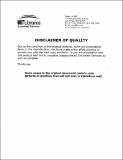Characterization of three Drosophila melanogaster regulators of programmed cell death that lead to caspase activation
Author(s)
Tittel, Jan N. (Jan Nils), 1971-
DownloadFull printable version (15.13Mb)
Alternative title
Characterization of 3 Drosophila melanogaster regulators of programmed cell death that lead to caspase activation
Other Contributors
Massachusetts Institute of Technology. Dept. of Biology.
Advisor
Hermann Steller.
Terms of use
Metadata
Show full item recordAbstract
Programmed cell death plays an important part in metazoan development as well as in disease. The morphology of cells undergoing programmed cell death has been carefully defined and found to be conserved between a variety of species. A number of key regulators of this process were first identified in the nematode Caenorhabditis elegans and then found to be conserved in Drosophila and mammals. In addition to the conserved components of the programmed cell death pathway, Drosophila contains three currently novel regulators: reaper, head involution defective (hid), and grim. The C. elegans gene ced-4 is necessary for the proper execution of programmed cell deaths during development. A mammalian homolog, Apaf-1, has similar functions. Until recently, a Drosophila homolog for this component of the core cell death pathway had not been identified. We describe the cloning and characterization of a Drosophila ced-4/Apaf-l homolog, which we named hac-1. HAC-1, like CED-4 and Apaf-1 is required for some cell deaths during development, can help activate caspases in vitro, and appears to aid in the activation of procaspases overexpressed in the Drosophila eye. Interestingly, like reaper, hac-1 transcription is rapidly upregulated in response to UV and X-irradiation. An essential regulator of programmed cell death in Drosophila is diap 1. Diap1 is part of a conserved family of Inhibitor of Anoptosis proteins (IAPs) that were first described in baculovirus. Loss of diap1 function results in widespread apoptosis during early embryonic development. In addition to the morphological features of apoptosis, caspases are activated and physiological caspase substrates are cleaved. We show that some of the morphological changes observed can be explained by the cleavage of two caspase substrates, nuclear Lamin Dffio and Armadillo. In order to identify additional components of the programmed cell death pathway and to further our understanding of how Reaper functions, we performed a yeast two-hybrid interactor screen using Reaper as the bait. We isolated ten potential interactors for which we determined the sequence, expression pattern, and cytological map position. None of these interactors has yet been shown to function in programmed cell death, but they provide leads to follow for future investigation.
Description
Thesis (Ph.D.)--Massachusetts Institute of Technology, Dept. of Biology, 2001. Includes bibliographical references.
Date issued
2001Department
Massachusetts Institute of Technology. Department of BiologyPublisher
Massachusetts Institute of Technology
Keywords
Biology.